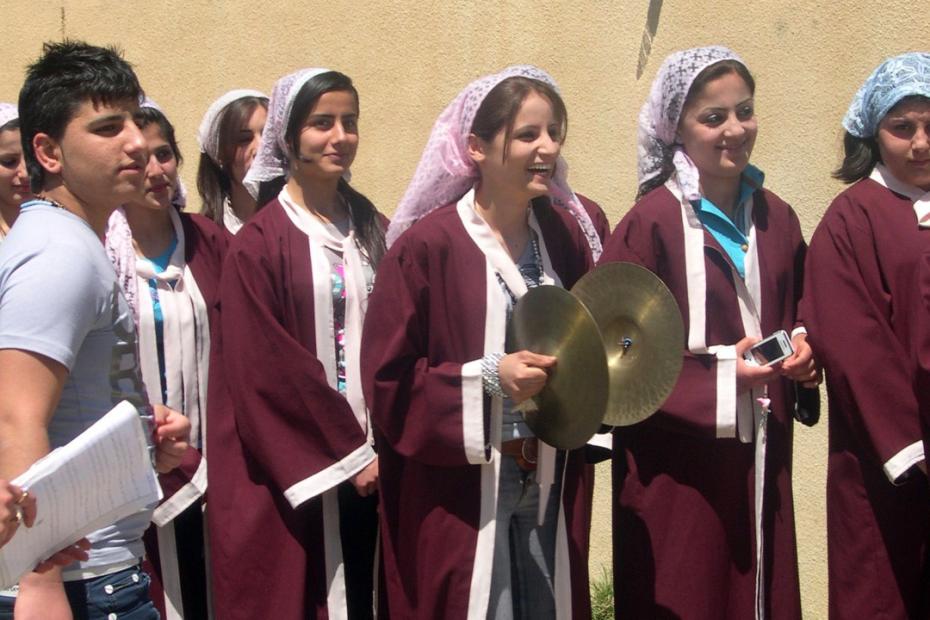Though Christianity is decidedly a minority faith in Iraq, Mesopotamia has been home to a sizable Christian population for almost two millennia. The Acts of the Apostles lists Mesopotamians among those in the upper room at Pentecost.1 Tradition has it that the Apostle Thomas and his followers Addai and Mari brought Christian faith in the first and second centuries A.D. to the lands that were the birthplace of Abraham.
The Sasanian Empire, which governed the region from 224 to 651 AD, was a fierce rival to the Roman Empire. Because of that, and for theological reasons, the Church in Mesopotamia severed relations with the Latin and Byzantine Churches following the Council of Ephesus (431 AD). The Church of the East, as it came to be known, led by the Patriarch of the East, adopted a Christological position known as Nestorianism, which had been condemned at the Council. After the Arab conquest and the consequent rise of Islam in these lands, Christians tended to live in distinct communities that spoke Syriac, a form of Aramaic, and worshiped according to the Liturgy of Addai and Mari. From the 14th century onward, a series of rapprochements and engagements between patriarchal contestants in the Church of the East and the Roman Church eventually yielded a longer-term relationship, enduring today as the Chaldean Catholic Church. Latin and several Eastern Catholic Churches also eventually established churches and schools here.2
Christians found a measure of protection at times under the Ottoman Empire, but also occasional spasms of violence toward them. The empire's collapse in 1915 brought chaos to the region and gave rise to the creation of the modern state of Iraq in 1920. Disparate peoples with no common sense of national identity were legally united within the bounds of Iraq's arbitrarily drawn boundaries. Iraq's monarchy was overthrown in 1958, in the first of a series of coups that led to the rise of Saddam Hussein, who was himself overthrown in 2003, after which Iraq saw even greater instability and an outflow of Christians, particularly when ISIS, the Islamic State, actively controlled large parts of the country.
More than 82% of Iraqi Catholics belong to the Chaldean Catholic Church, about 17% belong to the Syrian Catholic Church, and the remainder are primarily Armenian, Greek and Latin-rite Catholics.3
While Iraqi Christians have faced many serious setbacks in Iraq in the past, in the course of the 20th century, Catholic educational institutions had put Christians in a relatively good social position in Iraq. In 2003, there were five Christian newspapers, and eight Christian parties.4 According to Suha Rassam:
Before the second Gulf War, Christians made about 4-5% of the population, at roughly one million individuals. Of these, 70% are Chaldeans, the rest being Syrian Catholic, Syrian Orthodox, Assyrian Church of the East, Ancient Church of the East, as well as small numbers of Armenians, Protestants, Greek Orthodox and Greek Catholics, Copts, Latins, and Anglicans. The majority lived in the cities of Baghdad, Mosul, Basrah and the rest in the towns and villages of the plain of Mosul and Kurdistan. Since 2003, a significantly high number of these Christians have been displaced, and about half have left the country.5
In the post-Saddam era, there was discussion of creating an autonomous Christian region, such as the Kurds have.6 Rassam suggests that the majority of Iraqi Christians are not segregationist, do not belong to the distinctively Christian political parties, and reject the notion of a Christian enclave or “ghetto” in Iraq.7 Many of them prefer to live in Baghdad, for business and educational reasons, but also see the whole of Iraq as their home.
Much of what there is to write now about Iraq concerns the political and social unrest. Pope Francis' celebrated pilgrimage there in 2021 may well be a significant step in changing that narrative. In the future, we hope to be able to add more to this website about Iraqi culture, particularly as it affects Catholic practice and is reshaped by the political turmoil.
Read more on the Chaldean Catholic Church.
- 1Acts 2:9.
- 2For an overview of this history, see Fernando Cardinal Filoni, The Church in Iraq, trans. by Edward Condon, Washington: Catholic University of America Press, 2017. Despite the title, this is overwhelmingly a story of actors appointed by the Vatican, regrettably void of representation of how Iraqi Catholics have lived, practiced, or shaped their own religious lives. At the same time, it can be a useful source of information about relations at the elite level, and the ways that the Holy See acted to shape the life of the Church in Iraq.
- 3The Annuario Pontificio’s statistics on the dioceses of the Eastern Churches have been compiled by Ronald G. Roberson, CSP for various years from 1990–2017 are available at https://cnewa.org/eastern-christian-churches/toc/eastern-catholic-churches-statistics/?highlight=roberson.
- 4Archbishop Louis Sako, The Chaldean Catholic Church: A Story of Being, (Kirkuk, Iraq, 2009), 20-21.
- 5Suha Rassam, “Iraqi Christians: The Present Situation,” in The Catholic Church in the Contemporary Middle East, edited by Anthony O’Mahony and John Flannery (London: Melisande, 2010), 187-88.
- 6 Herman Teule, "The Christian Minorities in Iraq: The Question of Religious and Ethnic Identity," in In-Between Spaces: Christian and Muslim Minorities in Transition in Europe and the Middle East, edited by Christiane Timmerman et. al. (Brussels: Peter Lang, 2009), 50-56.
- 7Rassam, “Iraqi Christians: The Present Situation,” 199-202.
